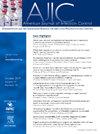Helicobacter pylori real-time quantitative PCR to examine efficacy of endoscope processing
IF 2.4
3区 医学
Q2 INFECTIOUS DISEASES
引用次数: 0
Abstract
Background
Helicobacter pylori (H. pylori) is the main cause of peptic ulcer disease. The primary aim of this research is to determine the effectiveness of current endoscope High-Level Disinfection (HLD) at clearing H. pylori. The secondary aim is to evaluate the prevalence of H. pylori in patients undergoing esophagogastric-duodenoscopy (EGD).
Methods
This is a prospective study collecting samples from esophagogastroduodenoscopy (EGD) for H. pylori. testing via gastric lavage and after HLD via flushing endoscope with sterile water. The patients’ records were reviewed and the fluid obtained was tested for microbiologic culture; urease testing, and qPCR testing using UreA primers and probe.
Results
The study included 202 samples (101 patients). H. pylori was positive in 37%, 21.9% and 2.4% of samples using Urease testing, culture and biopsy respectively. H. pylori was four times more likely to be identified via gastric lavage than by biopsy. qPCR was significantly more likely to be negative after HLD (27 vs 3 patients).
Conclusions
HLD was effective in reducing H. pylori but was not able to totally eliminate H. pylori DNA. qPCR is more sensitive than routine culture but can’t accurately determine potential for infection transmission. Gastric lavage may be more effective in detecting H. pylori than histology.
幽门螺杆菌实时定量PCR检测内窥镜处理效果。
简介:幽门螺杆菌(Helicobacter pylori, H. pylori)是消化性溃疡的主要病因。内窥镜检查和组织学检查是诊断幽门螺杆菌的确证性检查。本研究的主要目的是确定当前内窥镜高水平消毒(HLD)清除幽门螺杆菌的有效性。第二个目的是评估在接受食管胃十二指肠镜检查(EGD)的患者中幽门螺杆菌的患病率。方法:这是一项在胃肠道内窥镜单元进行的前瞻性研究,收集了HLD前后的食管胃十二指肠镜(EGD)样本。通过洗胃和HLD后获得的液体进行幽门螺杆菌检测。回顾患者的幽门螺杆菌病史和临床检查记录。经EGD获得的液体进行微生物培养试验;脲酶检测,以及使用尿素引物和探针进行qPCR检测。结果:纳入EGD 202份(101例)。EGD最常见的适应症是反流、胃肠道出血和腹痛。37%的样本尿素酶检测呈阳性,其次是培养(12.9%)和活检(4.9%)。通过洗胃发现幽门螺杆菌的可能性是活检的四倍。HLD后qPCR阴性的可能性更大(27例vs 3例)。结论:EGD的HLD能有效减少幽门螺杆菌,但不能完全消除幽门螺杆菌DNA。qPCR比常规培养更敏感,但不能区分活的和死的病原体,不能准确判断感染传播的潜力。洗胃在检测幽门螺杆菌方面可能比组织学检查更有效。
本文章由计算机程序翻译,如有差异,请以英文原文为准。
求助全文
约1分钟内获得全文
求助全文
来源期刊
CiteScore
7.40
自引率
4.10%
发文量
479
审稿时长
24 days
期刊介绍:
AJIC covers key topics and issues in infection control and epidemiology. Infection control professionals, including physicians, nurses, and epidemiologists, rely on AJIC for peer-reviewed articles covering clinical topics as well as original research. As the official publication of the Association for Professionals in Infection Control and Epidemiology (APIC)

 求助内容:
求助内容: 应助结果提醒方式:
应助结果提醒方式:


